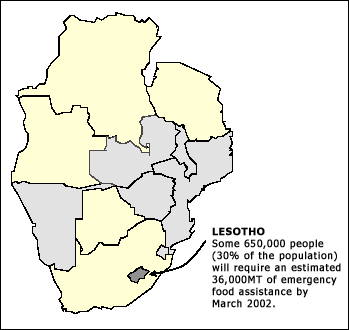
|
Lesotho National Vulnerability Assessment Committee
in collaboration with the SADC FANR Vulnerability Assessment Committee
Lesotho Emergency Food Security Assessment Report
16 September 2002 - Maseru
Prepared with financial support from DFID, WFP and USAID
|
Contact details Mr R Mugwara:
rmugwara@sadcfanr.org
SARPN acknowledges permission from the Food, Agriculture and Natural Resources Vulnerability Assessment
Committee to post this series of documents
|
|
|
|
[Download complete document  - 818Kb ~ 5 min (34 pages)]
[ Share with a friend - 818Kb ~ 5 min (34 pages)]
[ Share with a friend  ]
]
|

|
Context & Current Situation
One of the poorest countries in the world, Lesotho is a largely mountainous country of four agroecological zones – lowlands, foothills, mountains and the Senqu River Valley – completely
surrounded by South Africa. Erratic weather, including heavy rainfall, frost, hailstorms, and even a tornado have severely affected agricultural production and food security at the household,
community, district and national levels in Lesotho during the past two years. Sharply declining employment opportunities and rising staple food prices have adversely affected household
resilience to cope with the shock of declining food availability and access. Households already experiencing or extremely vulnerable to livelihood insecurity are now routinely employing what
used to be coping strategies, such as beer brewing, as their livelihood strategies. Like other Southern African nations, recent food security shocks must be understood in the context of the
longer-term deterioration of agriculture combined with the HIV/AIDS pandemic, (the country has the world’s fourth highest prevalence rate)
which has particularly impacted Lesotho households. This year, Lesotho households are paying much more for staple food products, including oil, maize,
and maize meal, than last year. The poorest households, who are forced to spend disproportionately more for food, have been particularly affected by the
price increases.
|
[Download complete document  - 818Kb ~ 5 min (34 pages)] - 818Kb ~ 5 min (34 pages)]
|
|






